Jeju 4·3 as a Universal Model: Beyond the Model of Truth and Reconciliation Toward the Model of Justice and Reconciliation
Park Myung-lim, Professor at Yonsei University
Park Myung-lim
Park has been with Jeju 4·3 since the 1980s when he visited the historical sites and interviewed people on Jeju to write a dissertation on Jeju 4·3. His major research areas include Korean politics, East Asian international relations, peace, and political theory. He served as a collaborative researcher of the Harvard-Yenching Institute at Harvard University, a visiting professor at the French School of Advanced Studies in the Social Sciences, a visiting professor at the Free University of Berlin, and an overseas chair professor at Jilin University. He is currently a professor at the Graduate School of Area Studies, Yonsei University, and the director of the university’s Center for Human Peace and Healing. His books include The Korean War: The Outbreak and Its Origins (Vol 1 and 2), Korea 1950: War and Peace, and History, Knowledge and Society.
The Land, an epic saga written by Park Kyongni, is regarded to have reached the highest level of contemporary Korean literature. The first chapter of the first volume begins with “Sound of footsteps in the darkness”. The last chapter of the last volume is titled “Into the light”. This is quite unusual. On the first day at the beginning of the novel, eyes gazing at the rising moon are subtly mixed with “moonlight, tears, and wishes”. On the last day, however, the main character, hearing the finale of national independence, “feels the chains that used to wrap around her falling to the ground with a loud noise.” Those “wishes in the beginning” that had been built up for a long time, and those “chains at the end” that fell off with a loud noise; what would they mean? After the chains are broken off of the main character, four repeated shouts of joy follow.
When the National Assembly passed the budget bill on the reparation for damage related to Jeju 4·3 this year, the scenes that came to my mind were the beginning and the end of The Land. It felt like our wishes came true after passing a long loop of time, while the unchaining happened so abruptly. Certainly, the long and exhausting life of Jeju residents, which resembles that described in The Land, entered my mind again. If the police firing on March 1 and the formidable tragedy of April 3 were the “sound of footsteps in the darkness”, would the law and a series of measures be the move “into the light”? Or, would they be a move from the “eyes full of wishes” to the “breaking of chains”?
From the beginning of the tragedy to today, Jeju 4·3, on both its bright side or its dark one, appeals to the world as one of the most obvious signs of an exemplary model of resolving past historical issues. Particularly, the resolution process after Jeju 4·3 is sufficient to set a universal model representing the world in relation to overcoming the past events caused by state violence which humanity faced in the 20th century. Of course, this statement is not an exaggeration. It is merely an expression of the objective facts that Jeju residents achieved through tolerance and wisdom.
Immediately after World War II ended, Jeju Island, off the tip of the Korean Peninsula — which was the outpost of the global ideological confrontation — turned into one of the most victimized areas of global ideological violence and the Cold War confrontation. Foreign forces and ideologies infiltrating the island, which had a strong sense of community, eventually resulted in excruciating bloodshed and slaughter. This means that the overall situation in the world and on the Korean Peninsula brought violence and slaughter to Jeju. Needless to say, this was a state-organized crime. As will be described later, however, Jeju shows in return justice and reconciliation, and forgiveness and generosity, to the Korean Peninsula and to the world.
Sadness, anger, oppression, and fear after the outbreak of Jeju 4·3 drove Jeju residents into a deathlike life. Corpses and despair covered the whole island. The entire island of Jeju has since evoked tears in our eyes. Thus, those with a courageous and gleaming spirit, who have endured the hardships that are as severe as the tragedy at the time of Jeju 4·3, help us take a pious attitude. It was oppression and perseverance that followed tragedy and slaughter. However, their inner longing and will for life and consolation of sorrow, discovery of truth and exoneration, and human rights and justice burned continuously and intensely behind the oppression. The wave of resistance from below against state power — the agent of violence, slaughter, and oppression — might have been weak and thin at the beginning; as time passed, it turned into a deeper and wider river. It was the strength of desperation and the product of human vitality.
It was a time when the victims, paralyzed during a nightmare, were still holding their breath, but the Jeju 4·3 activists and the victims’ families soon became united. After forming that spiritual and practical solidarity, a transition toward justice began at last from within Jeju. Since the 1980s, I have witnessed the transition in the field. The will and aspiration for truth and consolation of sorrow, and human rights and justice on Jeju, the subject and site of the tragedy, which is now called the Jeju 4·3 movement, was the starting point and source of all practices and struggles. This is why we divide Jeju 4·3 into the Jeju 4·3 massacre and the Jeju 4·3 movement. In other words, it was a model of participation from the bottom up towards justice. In this model, the Jeju community willingly acted to overcome Jeju 4·3.
When the eruption from below for consolation of sorrow and revelation of truth as well as pursuit of the value of life and justice was joined by the nationwide demand for democracy, efforts were finally made in earnest to overcome the past through laws and institutions, the national and local government bodies, and the legislature. It was a great leap forward and transition from the local to the center and from the movement to the institution. Therefore, with regard to the ideal gearing-up of participation from below and democratization of the country, Jeju 4·3 remains a world-class example.
In the end, it reaches a point where it can be called the Jeju 4·3 model. In other words, across all essential areas involving victims and their families and the state, victims and perpetrators, the private and public sectors, the national and local governments, and progressives and conservatives, Jeju 4·3 is a world-representative model that shows a universal path where dialogue and communication, compromise and coexistence, truth and apology, generosity and mutual prosperity, justice and reconciliation, healing and integration were harmonized at the highest level in a post-violence society. Dialogue led to compromise, truth brought about apology, justice coexisted with reconciliation, and generosity and healing brought about mutual prosperity and unity. It is indeed a praiseworthy route.
Just to touch on only the core processes and cases, there was ▲ the enactment of the Special Act on Discovering the Truth of Jeju 4·3 and Restoration of Honor to the Victims, or the Jeju 4·3 Special Act (legislation), ▲ the establishment and operation of the Committee for Discovering the Truth of Jeju 4·3 and Restoration of Honor to the Victims (organization), ▲ the approval, content, and publication of the Jeju 4·3 Incident Investigation Report (approval of the official national report), ▲ the establishment, nature, composition, operation, and role of the Jeju 4·3 Peace Foundation (executive body), ▲ the construction of the Youngmowon memorial site in Hagwi-ri and the expanded recognition of the victims ▲ the declaration of reconciliation and mutual prosperity announced by the Association of the Bereaved Families of Jeju 4·3 Victims and the Korean National Police Veterans Association, ▲ the designation of April 3 as a national memorial day and hosting of the memorial ceremony (official memorial ceremony), ▲ the general revision of the Jeju 4·3 Special Act and stipulation of reparation for damage and ex officio retrials. All stages, individual cases, and the entire process symbolize the exemplary nature and universality of Jeju 4·3 as if they were a compressed microcosm and entire landscape. We now need to conduct an in-depth study of each of these processes, mechanisms, and cases representing the Jeju 4ㅓ·3 model and present them to the world.
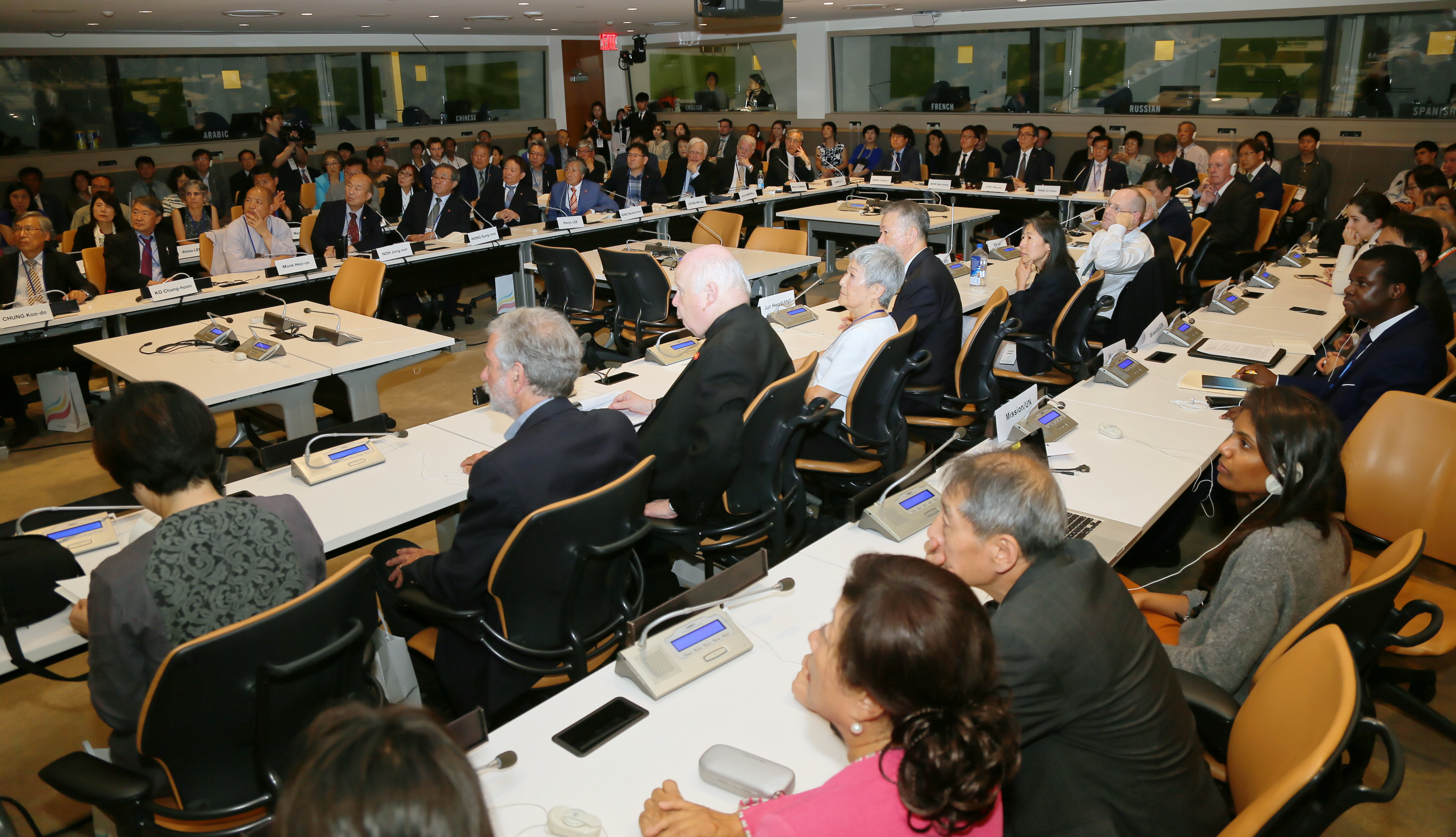
The participants of the U.N. Symposium on Human Rights and Jeju 4·3 show a keen interest in the Jeju 4·3 issues. The conference was hosted by the Permanent Mission of the Republic of Korea to the United Nations, and organized by the Jeju Special Self-Governing Province and the Jeju 4·3 Peace Foundation in June 2019.
The process of overcoming Jeju 4·3 is a wonder in which the whole process is demonstrated in each case and the specific case within describes the whole process. Every process reflects justice and reconciliation, the shared core spirit found in the process of overcoming Jeju 4·3. The Jeju people never considered justice and reconciliation as a mutually exclusive relationship based on the selection between one or the other. They pursued justice but did not give up on reconciliation; they dreamed of reconciliation but did not abandon justice. In that sense, Jeju 4·3 can be called a justice and reconciliation model that is capable of replacing, at the world level, the truth and reconciliation model represented by South Africa.
The simultaneous pursuit of justice and reconciliation led to democracy. Conversely, of course, adherence to the spirit of democracy was also manifested as the simultaneous realization of justice and reconciliation. As far as overcoming the Jeju 4·3 issues, the differences and confrontations between progressives and conservatives in the central authorities, legislature, political parties, and local governments created no particular obstacles. They ultimately accepted the agreement and demands of the Jeju community. That is, the resolution process of Jeju 4·3 itself is the only case in Korea with a serious social confrontation where the confrontation was overcome and a high-level democratic compromise was reached through the resolution process. This is a firm disproof that the tragedy of Jeju 4·3 was not a problem of ideological confrontation, and at the same time, a proof that its resolution was an evident process of realizing democracy.
However, there is an even more critical issue here. Before taking the matter to the national government and the National Assembly, an almost perfect agreement was already reached within the Jeju community through maximum discussion and deliberation. Over the past decades, I have witnessed this countless times in every node of policy and debate for the resolution of Jeju 4·3. Therefore, the resolution process of Jeju 4·3 can only be an extension of Jeju society’s advanced democratic consciousness and sense of compromise. They always avoided the maximalist line, the biggest hurdle in realizing democratic values, and pursued the minimalist virtues of self-control and moderation. This implies that the resolution process of Jeju 4·3 originated from Jeju and was accepted by the nation’s central authorities, which demonstrates a case of Korea overcoming the past through a path of compromise and a process of practicing democracy. The central forces presented to Jeju a violent confrontation, whereas Jeju taught the central forces to compromise.
As mentioned above, the world has considered South Africa’s truth and reconciliation model as the most representative path for overcoming the past. It has had an immense impact on the world. However, looking back with the present point of view, due to the many weaknesses and limitations found in the truth and reconciliation model, the justice and reconciliation model of Jeju 4·3 is considered to be a universal model that exceeds the truth and reconciliation model in almost all respects. In particular, Jeju 4·3 shows advanced achievements not only in the process of resolution, but also in terms of healing, recovery, integration, and stability after resolution. Victims’ bereaved families and Jeju residents also exhibit a very high level of participation and trust in the Jeju 4·3-related organizations and the administration, while actively networking and forming solidarity with them. Thus, from the perspective of sustainability, the process of overcoming Jeju 4·3 shows no regression or setback but has made stable progress.
In the meantime, the status of the Republic of Korea has advanced from a weak nation to a middle-income one, then again to a middle-power country, and now it stands at the entrance of being a developed country heading into being a leading country. I can’t help but feel proud and dignified. Over the past years, we have exported our goods and technologies to the world. Now, Korean steel, petrochemicals, automobiles, ships, and mobile phones can be found anywhere in the world. Cutting-edge products such as semiconductors and LCDs, TVs, and batteries are leading the world standards. We have also risen to a leading position in the fields of democracy and human rights, freedom and public health, and international accountability.
I insist we add one more aspect here. It is our mind and soul. To put it differently, it is a model of surmounting the past issues and achieving justice and reconciliation together, which is represented by Jeju 4·3. Koreans now have the Jeju 4·3 model of overcoming past historical issues, which exemplifies a desirable path in almost all aspects, including the revelation of truth, restoration of honor, apology and generosity, justice and reconciliation, reparation for damage, remembrance and memory, education for the future, and sustainability. Indeed, Jeju is a culmination where we have shown ourselves and the world our hopes and possibilities as human beings. This is why Korea, and the world, should appreciate Jeju and learn from it.
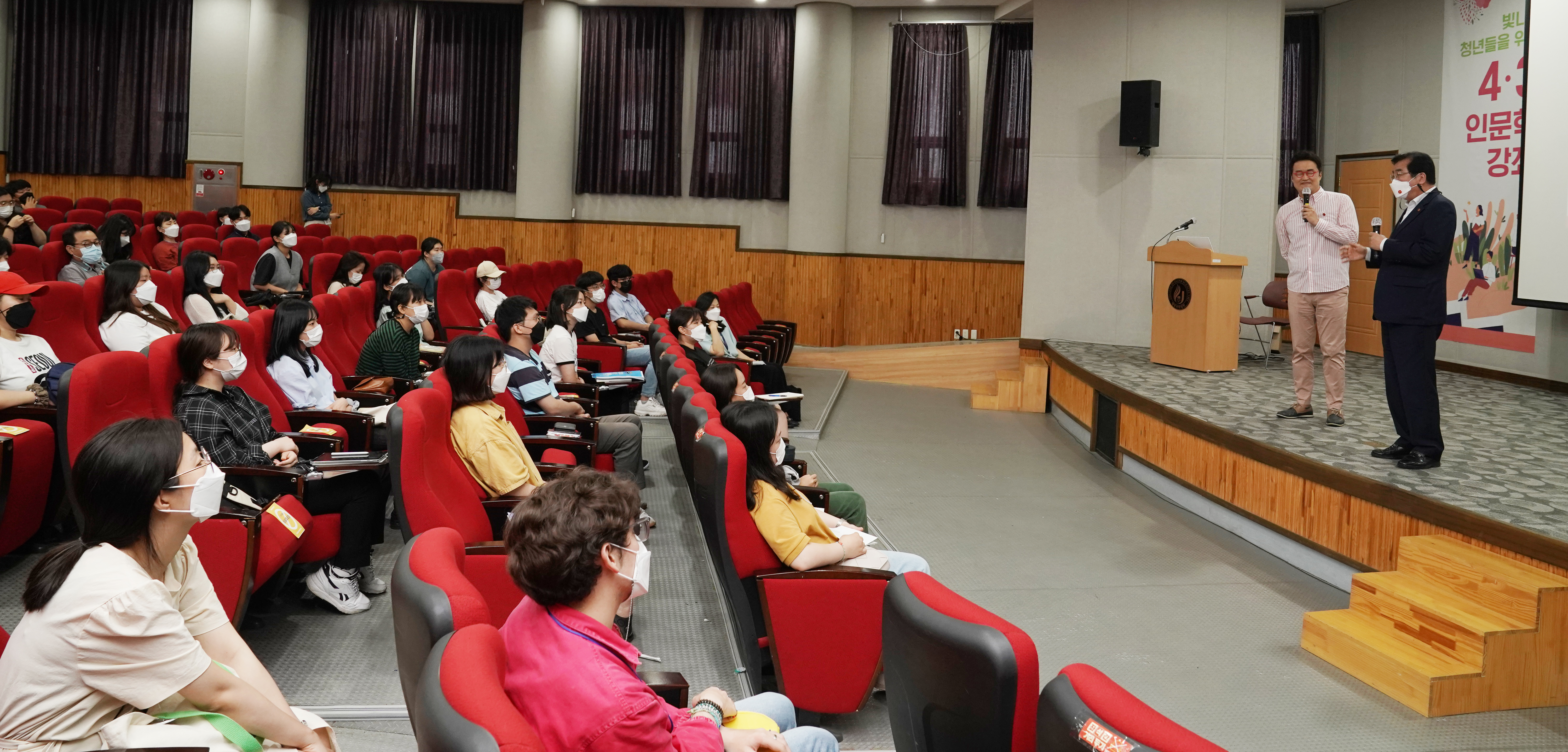 Choi Tae-sung, a Korean history lecturer, and Yang Jo Hoon, president of the Jeju 4·3 Peace Foundation, brief the students on the lessons learned from Jeju 4·3 and the role of the coming generations at the 4·3 Humanities Course for the Promising Youth, a Jeju National University lecture event held in the Ocean Hall at the school’s College of Ocean Sciences.
Choi Tae-sung, a Korean history lecturer, and Yang Jo Hoon, president of the Jeju 4·3 Peace Foundation, brief the students on the lessons learned from Jeju 4·3 and the role of the coming generations at the 4·3 Humanities Course for the Promising Youth, a Jeju National University lecture event held in the Ocean Hall at the school’s College of Ocean Sciences.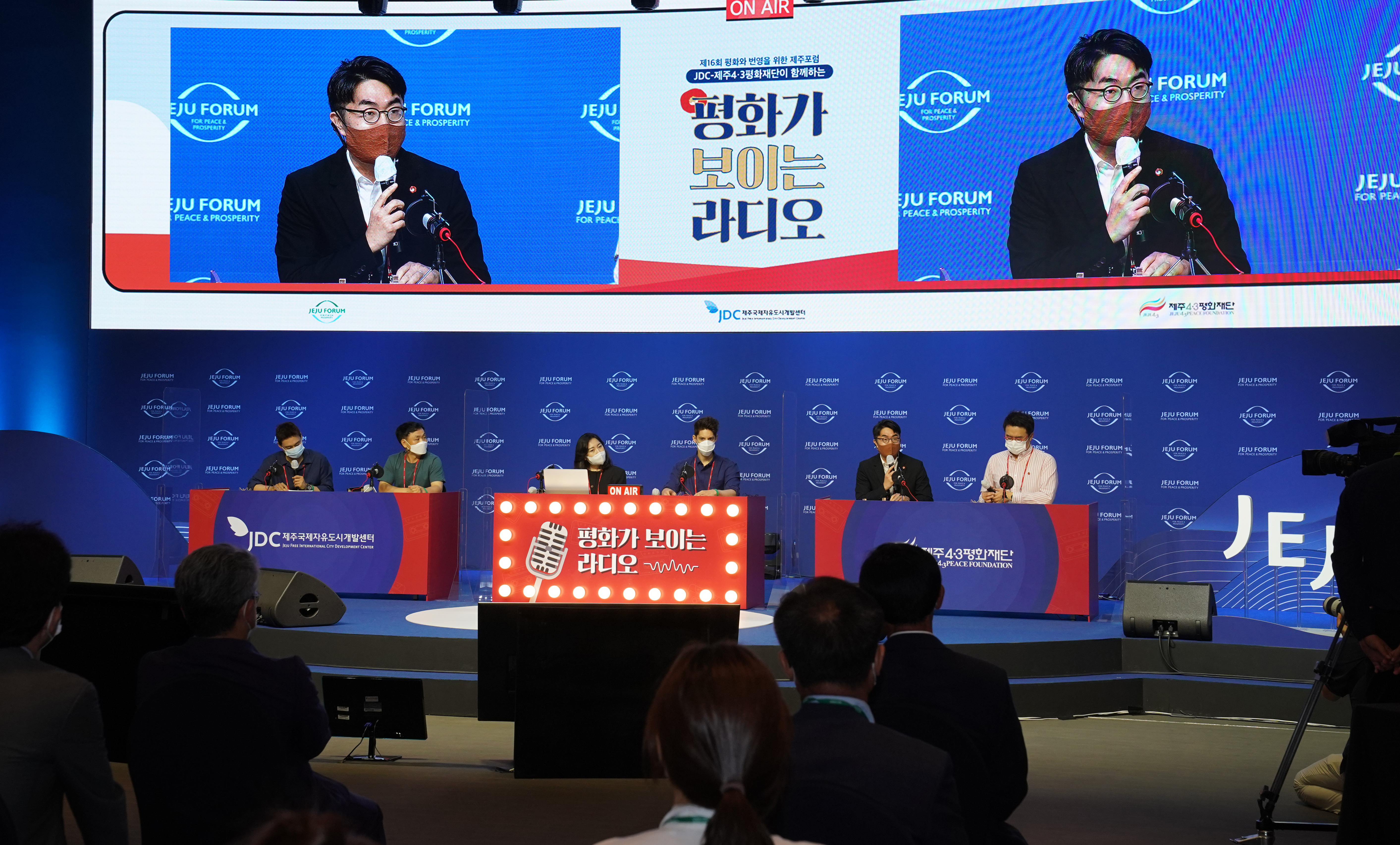 The Peace Radio Show of Youth session was held at Haevichi Hotel & Resort Jeju on June 24, as a side event of the Jeju Forum for Peace & Prosperity 2021.
The Peace Radio Show of Youth session was held at Haevichi Hotel & Resort Jeju on June 24, as a side event of the Jeju Forum for Peace & Prosperity 2021.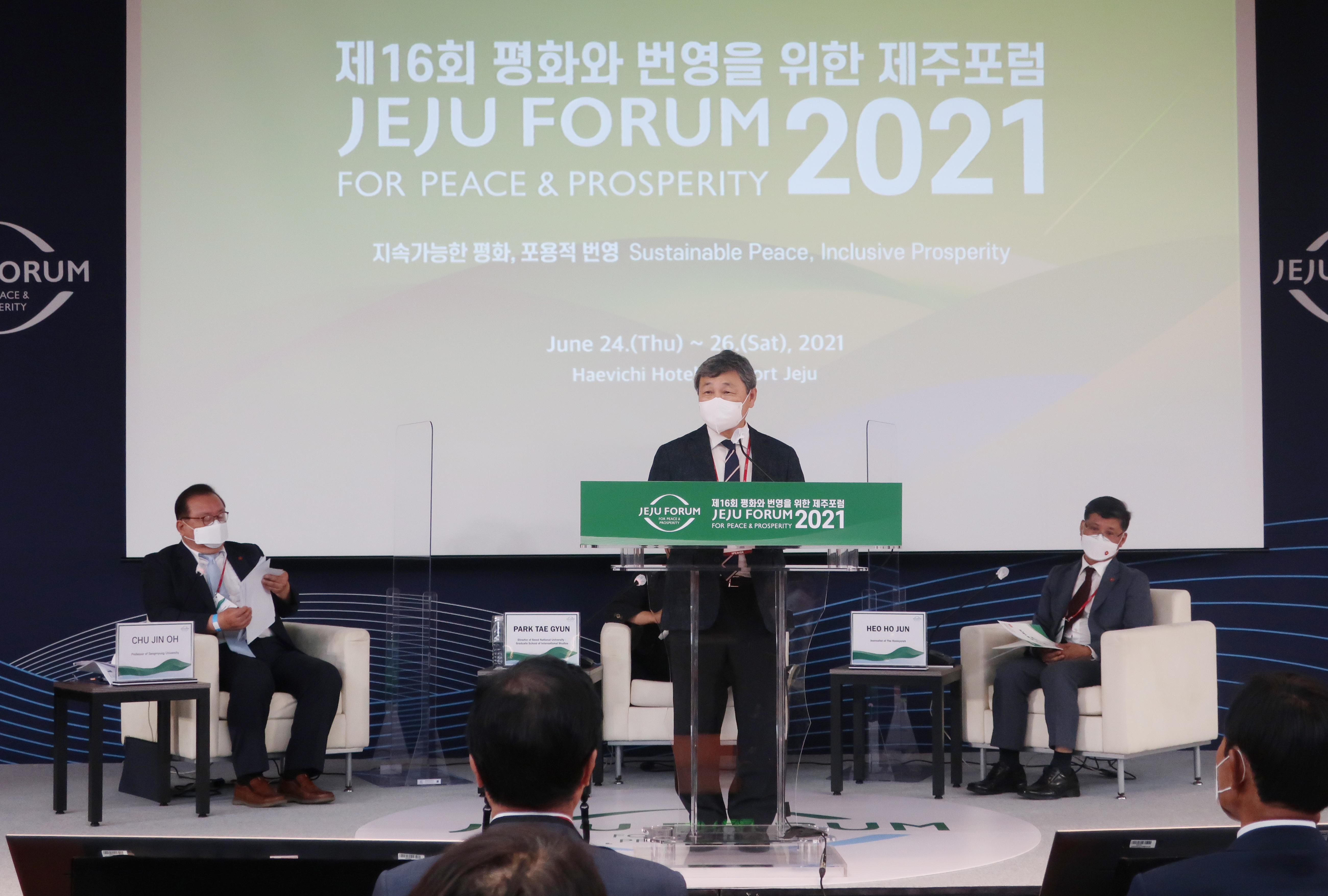 (From left) Professor Chu Chinoh of Sangmyung University, Professor Park Tae-gyun, the director of the Graduate School of International Studies at Seoul National University, Huh Ho-joon, a Hankyoreh senior correspondent attended the session, titled “4·3, World Cold War and Peace”. The session was hosted by the Jeju 4·3 Research Institute.
(From left) Professor Chu Chinoh of Sangmyung University, Professor Park Tae-gyun, the director of the Graduate School of International Studies at Seoul National University, Huh Ho-joon, a Hankyoreh senior correspondent attended the session, titled “4·3, World Cold War and Peace”. The session was hosted by the Jeju 4·3 Research Institute.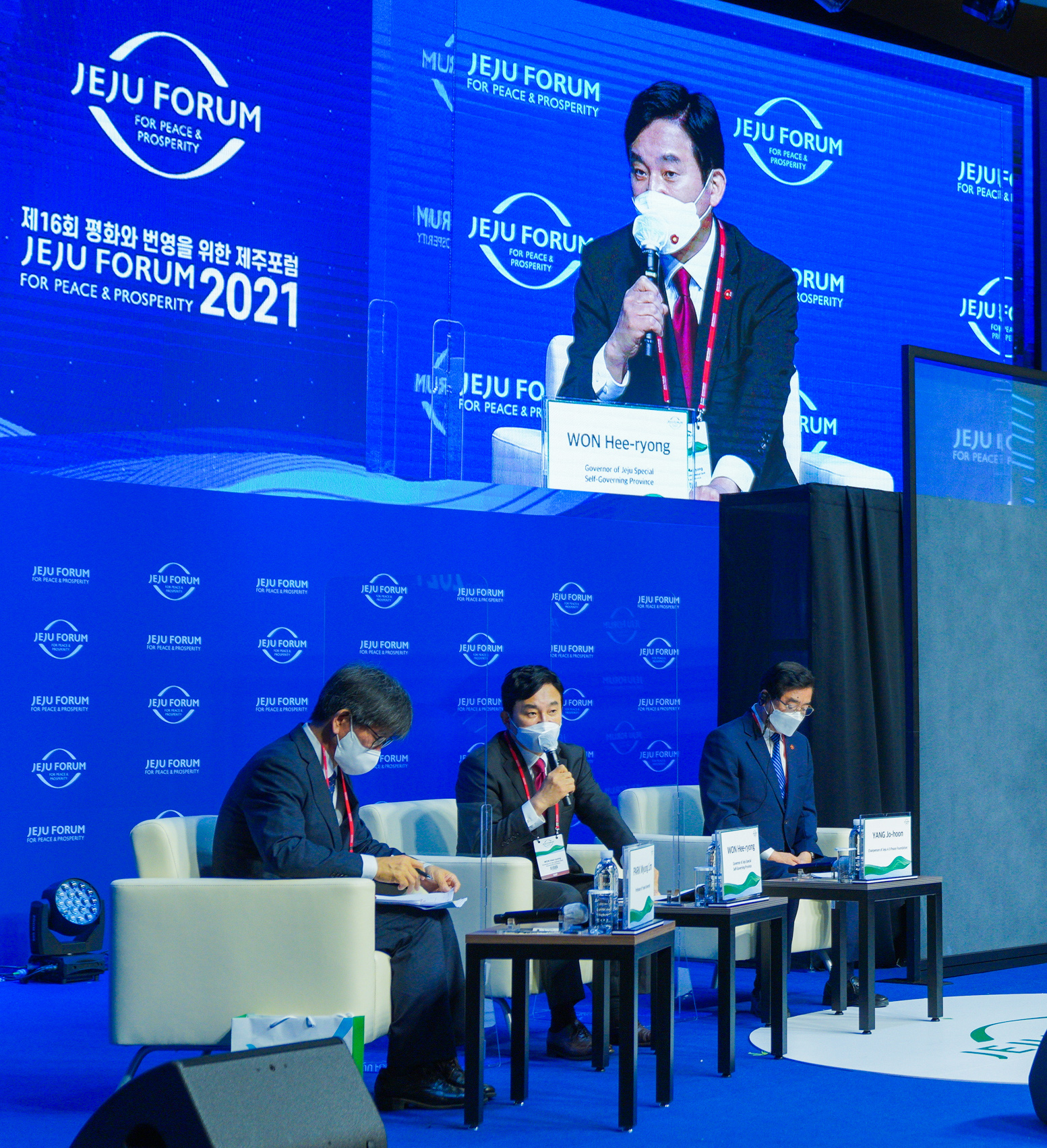 (From left) Park Myung-rim, a professor of Yonsei University, Won Hee-ryong, the governor of Jeju Special Self-Governing Province, and Yang Jo Hoon, the president of the Jeju 4·3 Peace Foundation met at the forum’s closing session, titled, “Towards a Universal Model of Reconciliation, Peace, and Healing: From Jeju to the World.”
(From left) Park Myung-rim, a professor of Yonsei University, Won Hee-ryong, the governor of Jeju Special Self-Governing Province, and Yang Jo Hoon, the president of the Jeju 4·3 Peace Foundation met at the forum’s closing session, titled, “Towards a Universal Model of Reconciliation, Peace, and Healing: From Jeju to the World.”